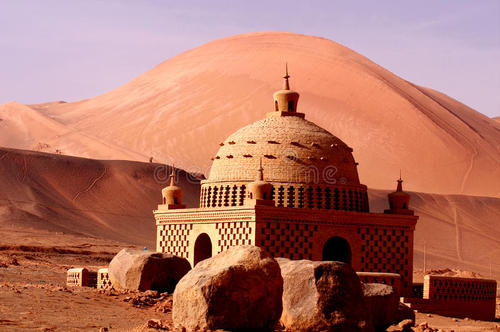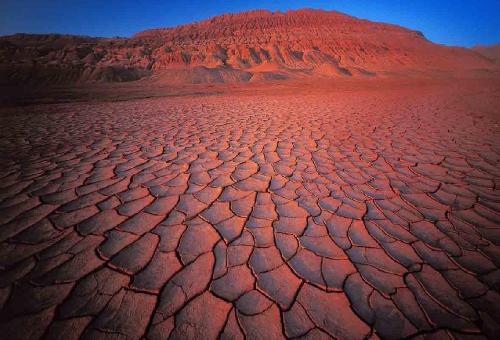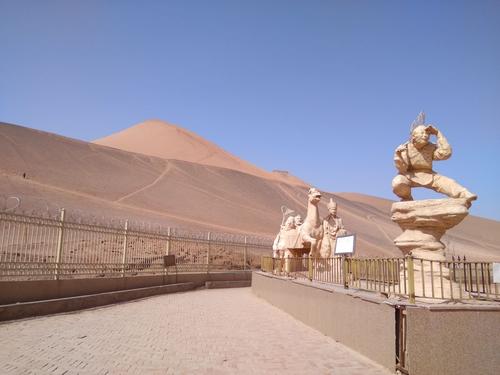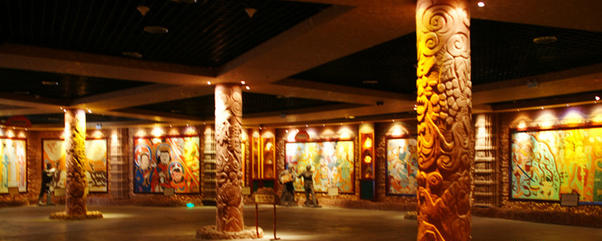Chinese Name: 火焰山 Pronunciation: Huǒyàn Shān
Average Height: 500 m
Peak Altitude: 831.7 m
Length: 98 km from east to west
Width: 9 km from north to the south
Address: Flaming Mountains Scenic Area, 28 km away from east of Turpan City, Xinjiang, China
1. Free for children under 6 years old and no taller than 1.2 meters.
2. Free for senior citizens over 70 years old (70 is included).
3. Free for special visitors who have the Disability Certificate(1-3 level).
4. Half-rate tickets for senior citizens between 65-69 years old (65 and 69 are included).
5. Half-rate tickets for students with Student Certificates.
6. Half-rate tickets for special visitors who have the Disability Certificate(4-6 level).
| Time | Peak Season | Off Season |
| Opening Hours | 8:00-21:00 | 9:00-18:30 |

Flaming Mountains is a national 4A-level scenic spot. It has been invested and operated by Turpan Flaming Mountains Tourism Co., Ltd. since 2003. It is located 28 kilometers away from Turpan City to the east, Xinjiang Province, on the northern edge of Turpan Basin. The 312 National Highway passes through the scenic spot. It is made up of red sandstone, starting from Langan Village in Shanshan County in the east and reaching Taoergou Village in Turpan in the west, like a red dragon lying in the Turpan Basin, 98 kilometers in length and 9 kilometers in width. The general height is about 500 meters, and the highest peak is near Tuyugou Valley in Shanshan County, with an altitude of 831.7 meters.
Flaming Mountains has long been famous, due to the classic Chinese novel Journey to the West by Wu Cheng’en. In Journey to the West, the story that the Monk Tang Sanzang was stopped by the Flaming Mountains from getting Buddhist scriptures, and the Monkey King borrowed the palm-leaf fan to put down the fire, happened here. It turned out that when the Monkey King created a tremendous uproar in the Heavenly Palace, he pushed down the blast furnace of Taishang Laojun, the Supreme Venerable Sovereign, and some of the firebricks fell to the ground with embers. At last, the Flaming Mountains formed. It is written in the Journey to the West: “Flaming Mountains has a flame of 800 miles, and no grass grows around it. If you climb the mountains, even the bronze skull and iron body will melt!” This passage appears to be exaggerated. However, the basic characteristics of high temperature and lack of vegetation are completely consistent with the actual situation of the Flaming Mountains. It’s not a figment. Now the Turpan Silk Road Art Museum in front of the Bezeklik Thousand Buddha Caves recreates the related story plot of Journey to the West.

The Flaming Mountains Scenic Area includes both natural and cultural landscapes. The underground palace covers an area of 9,000 square meters, including the Journey to the West Cultures Corridor, the Flaming Mountains’ Geography and Culture Hall, Gaochang Historical Celebrities Hall, the Giant Thermometer Display Hall, the “Flying over the Flaming Mountains” VR Experience Hall, and the Leisure and Shopping Center.
The Flaming Mountains is formed by the orogeny and the long-term wind and rain erosion. As a result, large and small gullies came into being. There was no grass on Flaming Mountains, and the maroon heat rose in the sun like fire. The annual rainfall is 16.6 millimeters, and the evaporation is 3,000 millimeters. In summer, the average surface temperature is 70°C and the highest can reach 89°C. Turpan, where the scenic spot is located, is known as the “lowest, driest, hottest and sweetest” place in China, while the Flaming Mountains is the hottest place in China.

The Flaming Mountains is a short fold in the front of Bogda Mountain which is in the east of the Tianshan Mountains. It was formed during the Indosinian--Early Yanshan Movement and set during the Himalayan Movement. The mountain range began forming 140 million years ago. The basic geomorphic pattern was also formed, which had gone through a long geological period, spanning several geological ages of Jurassic, Cretaceous, and Tertiary.
Flaming Mountains is located in the Turpan Basin. The local people call it “keziletage”, which means “red mountain”. On the road from the east of Turpan to Shanshan County, there are more than 100 kilometers of rolling red peaks. It is mainly composed of red sand, conglomerate, and mudstone which were formed during Mesozoic Jurassic, Cretaceous, and Tertiary. The mountain is vigorous and tortuous, and the slopes are full of gullies mainly by the erosion of water flow in ancient times. There is no grass on the mountains. The bedrock is bare, and often covered by weathered sand layer. In midsummer, the red rocks with sizzling heat waves, wreathing red smokes, and rising hot gas flows, glitters in the scorching sunshine, which is just like a group of flames in the burning, hence the name Flaming Mountains.

Walking on the ground of Flaming Mountains, you will feel like you are being baked by a stove. Lifting your eyes, what in your sight is a red ochre mountain, which is the main peak of the Flaming Mountains, Shengjin Peak, about 851 meters above sea level. The Flaming Mountains, with its mountainous peaks and undulating mountain ranges, crisscrosses and zigzag folds, looks like rolling heat waves in the sunlight. In addition, the surface of the mountain is bare of grass, the temperature is above 70°C and the sun is burning on the exposed red sandstone. It’s more like a burning fire. Therefore, during the Northern and Southern Dynasties, it was called “Red Stone Mountain”, and in the Tang Dynasty, it was called “Fire Mountain”. From the early Ming Dynasty, it was officially called “Flaming Mountains”. As a result, Turpan was called “The Fire Land”. In the north of the landscape area, there are large bronze sculptures of the Monkey King, Princess Iron Fan, and Bull Demon King.

Looking from the northwest of 312 National Highway, on the top of the Flaming Mountains, there is a stone pillar, which looks like a wooden stake, known as “the Hitching Post”. Hitching Post and Stepping Stone are 10 km away from Shengjin Township in Turpan City to the southwest. It is said that the Monk Tang Sanzang once tied the White Dragon Horse to the stone pillar when he passed by on the pilgrimage for Buddhist scriptures in the west. This is how the Hitching Post gets its name. Not far from the Hitching Post, there is a huge stone, which is said to be the stepping stone for Tang Sanzang to mount on a horse. There’s also another saying about the Hitching Post. It is said that in the period of Muhammad, a holy man named Eli came to the Flaming Mountains and tied his horse to the stone pillar. Later, people called this stone pillar “the hitching post” as a memorial.
Driving from Mutou Valley into the hinterland of the Flaming Mountains, you can see the group sculptures of the Monk Tang Sanzang and his apprentices who went to the West for Buddhist scriptures. The Monkey King, Sun Wukong, floats in the clouds, carrying the palm-leaf fan in front of the way, and Tang Sanzang is holding the White Dragon Horse, with Pigsy and Monk Sha, walking slowly. The group sculptures are vivid, with lifelike expressions, which were constructed in 1989. It is one of the new scenic spots of the Flaming Mountains, attracting numerous visitors from home and abroad.

Entering the Underground Palace of the Flaming Mountains, the first thing we see is the Journey to the West Cultures Corridor. 24 vivid reliefs show the hardships of Tang Sanzang and his apprentices during the journey. The Geography and Culture Hall displays the topography of Flaming Mountains with a miniature sand table, and the frescoes and relief characters on the surrounded walls systematically introduce the local customs and geographical culture of Turpan. The Gaochang Historical Celebrities Hall displays 14 lifelike figure sculptures, and the vivid frescoes, copies of the stolen ones according to a one-to-one ratio, present to tourists the history of the Flaming Mountains and the looters’ ugly faces.
In the center of the inner ring of the Underground Palace stands a huge thermometer, which was completed on August 16, 2004, and named “Golden Cudgel”. It is the largest thermometer in the world. The giant thermometer has a diameter of 0.65 meter, a height of 12 meters. It can measure the surface temperature and air temperature within 100 degrees Celsius. The wall surrounding the huge thermometer is 4 meters high. The relieves on the wall depict a series of stories in which the Monkey King caused havoc in the Heavenly Palace, and the Monkey King was put into the alchemy furnace of Taishang Laojun, and then turned over the alchemy furnace, forming the Flaming Mountains. You can take a picture in front of the “Golden Cudgel” which is included in the Guinness World Records, and keep the surface temperature in your travel memory. You can also experience the most detailed geographical and cultural knowledge of Flaming Mountains in the VR experience hall.

1. In those days, the Monkey King Sun Wukong, caused havoc in the Heavenly Palace. He knocked down the blast furnace of Taishang Laojun, and several pieces of hot coals fell from the sky and landed on Turpan, forming the Flaming Mountains. The mountain was originally on a raging fire. The Monkey King used a palm-leaf fan to extinguish the fire. After cooling, it became what it is today.
2. Uyghur folklore says that deep in the Tianshan Mountains, there was a vicious dragon who ate boys and girls. The local supreme ruler specially sent a brave warrior to subdue the dragon in order to kill the evil and bring safety to the people. After a thrilling battle, the dragon was killed by him at QiJiaoJing, northeast of Turpan, and the whole mountain was red with the dragon’s blood. Therefore, the Uyghurs called the mountain the Red Mountain, which we now call Flaming Mountains.

On the Gobi Desert at the foot of the Flaming Mountains, archaeologists have accidentally discovered 1,100 ancient tombs, with more than 1,000 remaining unexcavated in the small village, Yanghai. Among them, the earliest can be traced back to the Bronze Age, and the latest was also about 2,000 years ago. The time span is up to one thousand years. But on the whole, burial customs have not changed substantially during the 1,000 years, which allows us to paint a picture of a group of Yanghai people whose lives were monotonous and continuous. The Yanghai Tombs is the grandest prehistoric cemetery known in Turpan Basin and its surrounding areas. It is so well-preserved because of the dry environment of the Flaming Mountains that it has become an “ancient witness” for modern people to know Turpan.
1. The temperature difference between day and night is large, so it is best to bring some warm clothes.
2. Flaming Mountains is also known as the home of fruits, but do not drink hot tea after eating fruit, or you will get diarrhea.
3. Flaming Mountains is located in the northwest, with high altitude and strong ultraviolet radiation. So sufficient and effective sunscreen should be prepared. And you should be equipped with heat prevention medicine.
4. Flaming Mountains is a minority area with strong religious color. Therefore, tourists should remember to respect Muslim customs to avoid misunderstandings.
5. As the tourist route to the Flaming Mountains is long, and the scenic spots are scattered, so the ride time is long. The scenery along the way is relatively simple, so please be prepared for hardship. Some scenic spots, such as Tianchi Lake and pastures, require you to get off and walk, climb mountains or ride horses or camels to experience the pleasure of traveling.
Take a shuttle bus from Turpan Bus Station to Flaming Mountain Scenic Area, it takes about half an hour.
Chinese: 请带我去火焰山。English: Please take me to the Flaming Mountains.
If you go to the Flaming Mountains Scenic Area from Turpan Jiaohe Airport, It takes about 45 minutes (100 yuan).
If you go to the Flaming Mountains Scenic Area from Turpan North Railway Station, it takes about 50 minutes (110 yuan).
If you go to the Flaming Mountains Scenic Area from Turpan Railway Station, it takes about 85 minutes (200 yuan).
